Welcome back to Magic Gatherings!
Last week we talked about the major mechanics of Shadows over Innistrad, the hot new set on the block. This week we’re talking about sizing and archetypes. As I write, Pro Tour Shadows over Innistrad is happening in Madrid, so if you crave more SoI limited action, you could hardly do worse than to watch some of the best players in the world draft the new format.
Sizing
Here’s the chart for common creature sizes in Shadows over Innistrad:

The big takeaway here is that powers and toughnesses tend to be tightly clustered around 2 and 3. 4-toughness creatures block pretty well; there aren’t many 4-power creatures, and they tend to have low toughness, so they risk trading down against weaker creatures. 5-toughness creatures are distinctly difficult to get through. As a 6/6, [mtg_card]Kessig Dire Swine[/mtg_card] is the largest natural creature in the format. Only [mtg_card]Gatstaf Arsonists[/mtg_card] and [Silburlind Snapper] can tussle with it at common.
That means a card that gives +3 to a stat is a substantial jump up the curve, one which does enough to work to make your creature difficult to block. [mtg_card]Spiteful Motives[/mtg_card] and [mtg_card]Equestrian Skill[/mtg_card] are pricey—and, as Auras, a little risky—but they offer a lot of power. [mtg_card]Hope Against Hope[/mtg_card] can be quite strong; it can give +3/+3 or more easily, and first strike matters a lot more when powers and toughnesses are more tightly bunched. +2/+2 ([mtg_card]Strength in Arms[/mtg_card], [mtg_card]Senseless Rage[/mtg_card]) can be meaningful, but it’s not a guarantee.
This is a format that can produce some aggressive draws, but if your plan is to block, that should work out well. Consequently, while you can’t ignore the early game, you can expect the game to go long. What’s fun about the format is that aggressive decks have additional utility as the game drags out (Clues, delirium), while more controlling decks have the ability to put powerful engines in play that can take over the game.
What might those engines look like? What sorts of aggressive decks keep them honest? Glad you asked. Let’s take a look at the major archetypes.
Major Archetypes
Werewolves—Chief of the Fun Police is the green-red Werewolf deck, which severely punishes decks that can’t make plays in the first few turns. We covered the transformation mechanic last week, but to review: if a turn goes by without a player casting a spell, all werewolves transform to their werewolf side. If a single player casts two spells on one turn, all werewolves transform back to their human side. This means it’s very dangerous to miss a play in the second, third, or fourth turns of the game. At the same time, werewolves’ theriomorphic sides have some beefy stats, so the deck has play into the later turns as well.
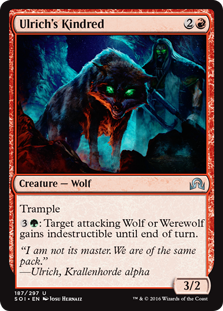
One wrinkle in Shadows limited is that it lacks the now-customary gold uncommon cards that point to major archetypes. Instead, we have a slightly more subtle cycle of cards with off-color activated abilities. In this case, it’s [mtg_card]Ulrich’s Kindred[/mtg_card], which makes blocking tough for your opponent. (Play special attention to activated abilities for this deck, as they give you productive ways to spend your mana that don’t count as casting spells. [mtg_card]Duskwatch Recruiter[/mtg_card] is an especially good one.)

That’s not the whole story, though. Each archetype has multiple powerful uncommons that aren’t multicolored, but still reward a dedicated strategy. [mtg_card]Howlpack Resurgence[/mtg_card] is obviously a “werewolf” card, but keep an eye out for more subtly synergistic cards that can aid your deck’s general plan.
Vampires—I can’t do any better than one of the game’s true masters, who went 3-0 with this deck on Day 1 of Pro Tour Shadows over Innistrad:
Ended up here after taking Elusive Tormentor p1p1 over Olivia, then opening Olivia pack 2. #PTSOI pic.twitter.com/wIZixyWIOf
— Luis Scott-Vargas (@lsv) April 22, 2016
As you can see, Vampires will typically be an aggressive black-red deck and will usually feature madness as a major theme. Last week I mentioned that [mtg_card]Insolent Neonate[/mtg_card] was a real bellwether for madness: it’s a great card in decks that really abuse madness, but mediocre in decks that don’t. LSV’s deck features seven cards that naturally have madness, plus [mtg_card]Falkenrath Gorger[/mtg_card], which can give every vampire in the deck madness. Meanwhile, the “black-red” uncommon is [mtg_card]Olivia’s Bloodsworn[/mtg_card], and LSV has managed to pick up a cool three copies.
[mtg_card]Elusive Tormentor[/mtg_card] over [mtg_card]Olivia, Mobilized for War[/mtg_card] is a Pro Tour pick—pros highly value not committing to two colors right away, which is sounds strategy in a draft with such high stakes.
Zombies—Less mechanically anchored than Vampires or Werewolves, Zombies will usually be a more controlling blue-black deck that gets value off discarding cards. Sometimes this will include madness, but other times it will be cards like [mtg_card]Ghoulsteed[/mtg_card] and [mtg_card]Stitchwing Skaab[/mtg_card], who can come back later. [mtg_card]Drunau Corpse Trawler[/mtg_card] is the marquee uncommon for this archetype; while expensive, its ability to grant deathtouch can be very difficult to attack into.
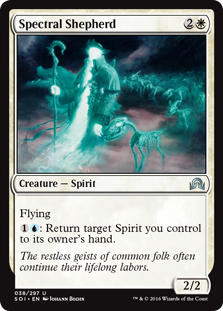
Spirits—Like Zombies, Spirits is a deck that’s less mechanically emphatic, and more a particular expression of a classic draft archetype—in this case, white-blue flyers. Not many creatures in SoI have reach, so flying creatures can be difficult to block. Defend yourself with a strong blocker like [mtg_card]Silent Observer[/mtg_card], and your air force can end the game. Keep an eye out for [mtg_card]Essence Flux[/mtg_card]; it’s a good example of an uncommon that’s seeded for one archetype, but which has utility for other decks.
Humans—The white-green archetype focuses on Humans. Cards like [mtg_card]Intrepid Provisioner[/mtg_card], [mtg_card]Hope Against Hope[/mtg_card], and [mtg_card]Veteran Cathar[/mtg_card] explicitly call out tribal synergies, but as my draft deck from last week’s article indicates, it can be enough to combine efficient green and white creatures with the staying power of cards like [mtg_card]Dauntless Cathar[/mtg_card] and [mtg_card]Nearheath Chaplain[/mtg_card].
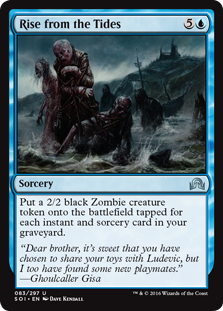
Prowess/Spells Matter—More and more, we’re seeing blue-red archetypes trend toward generic “play spells” decks. Shadows continues this pattern, featuring [mtg_card]Sanguinary Mage[/mtg_card] and [mtg_card]Niblis of Dusk[/mtg_card] as commons with prowess alongside [mtg_card]Pyre Hound[/mtg_card], which has a kind of “permanent prowess.” [mtg_card]Rise from the Tides[/mtg_card] is a great example of an uncommon that can be stellar in this archetype, even though it’s not obviously pegged as a red/blue card—playing those colors together naturally leads one to play lots of spells, which makes Rise great. Look for madness themes here too, especially as you have access to [mtg_card]Mad Prophet[/mtg_card] and [mtg_card]Reckless Scholar[/mtg_card].
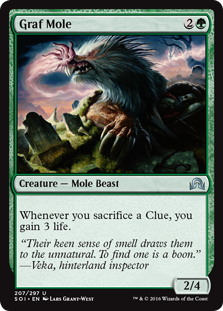
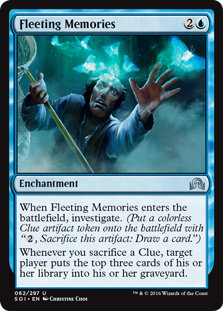
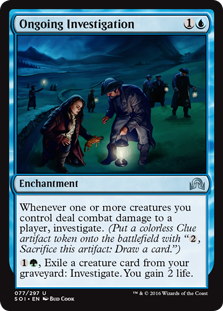 Investigation—Blue and green play especially well with Clues, so decks focused on investigate will trend in that direction. But there are enough flexible engine cards that generate value from Clues (and generate Clues in different ways) that these decks can look and play very differently. As you draft these decks, make sure to include enough defensive cards that you can protect yourself in the early turns, as it can take time to set up. Prioritize cards that generate Clues over and over. If your engine is consistent, you should be able to take over in the late game.
Investigation—Blue and green play especially well with Clues, so decks focused on investigate will trend in that direction. But there are enough flexible engine cards that generate value from Clues (and generate Clues in different ways) that these decks can look and play very differently. As you draft these decks, make sure to include enough defensive cards that you can protect yourself in the early turns, as it can take time to set up. Prioritize cards that generate Clues over and over. If your engine is consistent, you should be able to take over in the late game.
Delirium—Usually, Delirium decks will be black-green, taking advantage of cards like [mtg_card]Crow of Dark Tidings[/mtg_card] and [mtg_card]Vessel of Nascency[/mtg_card] to stock the graveyard, then winning with cards like [mtg_card]Autumnal Gloom[/mtg_card]//[mtg_card]Ancient of the Equinox[/mtg_card]. Uncommons like [mtg_card]Crawling Sensation[/mtg_card] and [mtg_card]Call the Bloodline[/mtg_card] can help get various card types into the graveyard, while generating useful tokens at the same time.
While these cards are centered in black and green, all colors have cards with delirium, so the mechanic could potentially be a sub-theme in any number of decks. In these cards, pay special attention to artifacts and enchantments, as those are usually difficult to get into your graveyard. Cards like [mtg_card]Wicker Witch[/mtg_card] can be good role-players, because they give you an easy way to get an unusual card type into your discard pile.
Drafting On
While this quick review covers the major draft archetypes of Shadows over Innistrad, it’s not the whole story. SoI is a set that’s particularly rich in draft-around cards that can become the focus of decks in their own right—single-card archetypes, if you will. Keep your eyes peeled for cards that ask you to do something specific, and be open to the possibility of drafting around them. If it seems like fun, go for it! You probably can.
At the same time, if you find yourself in a color pair with an “established” archetype, be open to drafting a deck that has a different focus than you might expect. As we mentioned, delirium decks can span all colors, and often require very different cards than the “normal” archetype for a particular color pair. Always have a plan, and ask yourself what cards need to be in your deck for that plan to succeed.
That’s all for this week! I’ll be back next week with a special deckbuilding exercise. In the meantime, if you happen to be at PAX East this weekend, come find me in Tabletop—I’m demoing a certain card game about cartoon horses that solve friendship problems. Feel free to stop by and say hello!
